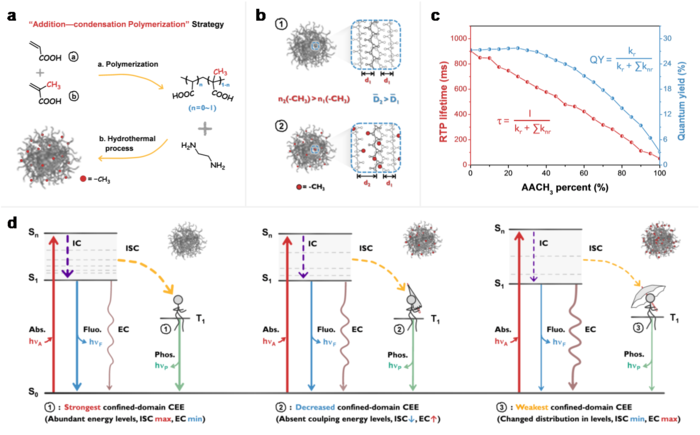The rapid growth of luminous carbon-based nanomaterials (carbon dots, CDs) during the last decade has been one of the most promising ways to create effective luminescence through simple synthesis. CPDs are being studied extensively as a new subclass of CDs. Then, there is the question of what is glowing and why is it shining.
 A, schematic of the “addition-condensation polymerization” strategy to investigate the confined-domain CEE in CPDs. B, schematic of the relationship between the methyl groups and the internal structure of CPDs (d1: the spacing of the original skeleton inside CPDs without methyl groups. D2: the spacing of the stretched skeleton inside CPDs by methyl groups. N: the amount of introduced methyl groups in CPDs. D: the average skeleton spacing of CPDs). C, RTP lifetimes in solid state and QYs in solution state of CPDs with different contents of methyl groups. D, schematic effect of confined-domain CEE on the energy levels of CPDs (IC: internal conversion, Abs.: absorption, Fluo.: fluorescence, Phos.: phosphorescence). Image Credit: By Songyuan Tao, Changjiang Zhou, Chunyuan Kang, Shoujun Zhu, Tanglue Feng, Shi-Tong Zhang, Zeyang Ding, Chengyu Zheng, Chunlei Xia, And Bai Yang.
A, schematic of the “addition-condensation polymerization” strategy to investigate the confined-domain CEE in CPDs. B, schematic of the relationship between the methyl groups and the internal structure of CPDs (d1: the spacing of the original skeleton inside CPDs without methyl groups. D2: the spacing of the stretched skeleton inside CPDs by methyl groups. N: the amount of introduced methyl groups in CPDs. D: the average skeleton spacing of CPDs). C, RTP lifetimes in solid state and QYs in solution state of CPDs with different contents of methyl groups. D, schematic effect of confined-domain CEE on the energy levels of CPDs (IC: internal conversion, Abs.: absorption, Fluo.: fluorescence, Phos.: phosphorescence). Image Credit: By Songyuan Tao, Changjiang Zhou, Chunyuan Kang, Shoujun Zhu, Tanglue Feng, Shi-Tong Zhang, Zeyang Ding, Chengyu Zheng, Chunlei Xia, And Bai Yang.
Professor Bai Yang of the State Key Laboratory of Supramolecular Structure and Materials, College of Chemistry, Jilin University, China, and collaborators have revealed the new study progress on the PL mechanism of CPDs in responding to these two major scientific problems in a new paper published in Light Science & Application.
Researchers presented strong evidence that the spatial impact inside the limited area of CPDs plays an important role in PL formation. Researchers proposed confined-domain CEE and built a well-defined model system of CPDs based on the “addition-condensation polymerization” approach to examine the effect of spatial interactions on PL.
Scientists polymerized acrylic acid and methyl acrylic acid in different amounts, then used a hydrothermal technique to make CPDs from the copolymers and ethylenediamine. It was hypothesized that the adjustable amount of methyl groups in copolymers would result in varying degrees of steric hindrance.
Physical characterizations and theoretical computations both confirmed that such interactions came from confined-domain CEE. These researchers examined and evaluated several intriguing occurrences and experimental evidence, demonstrating that confined-domain CEE contributes to the PL in CPDs:
“1) The spatial interactions and PL performance could be tuned by tuning the steric hindrance present in the interior of the CPDs.
2) Results from the structural characterizations demonstrated the introduction of methyl groups enlarged the spacing of chains inside nanoparticles.
3) The analysis of the femtosecond transient absorption spectral profiles revealed the existence and influence of confined-domain CEE on energy levels.
4) The theoretical calculations proved the rationality of the conjectured luminescent units and the proposed PL mechanism.”
“This study is first where confined-domain CEE in CPDs has been experimentally studied. These results can potentially help understand the unique structural advantages of CPDs and precisely tune their PL properties,” researchers added.
Researchers noted, “CPDs exhibiting tunable RTP lifetimes can be potentially used as smart materials to develop multi-level anti-counterfeiting technology, that is a hot field of recent study.”
Scientists explained, “The results revealed that the confined-domain CEE exerted significant spatial influence on PL. The ‘addition-condensation polymerization’ strategy could be adopted to tune the properties of the CPDs. Various factors, such as the type of the monomer precursors, the ratios of the constituent monomers, and the degrees of polymerization, could be precisely tuned to modulate the properties of the CPDs.”
“Thus, the synthesis of CPDs can eliminate the simple choices of existing compounds as the current stage, and become more targeted. Our findings can potentially help understand the PL mechanism of CPDs, and inspire a novel synthetic design to obtain CPDs with tailored properties,” they concluded.
Journal Reference:
Tao, S., et al. (2022) Confined-domain crosslink-enhanced emission effect in carbonized polymer dots. Light: Science & Applications. doi.org/10.1038/s41377-022-00745-4.